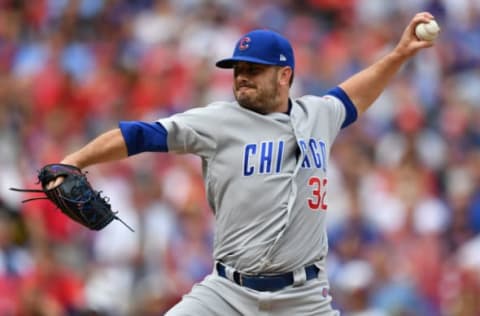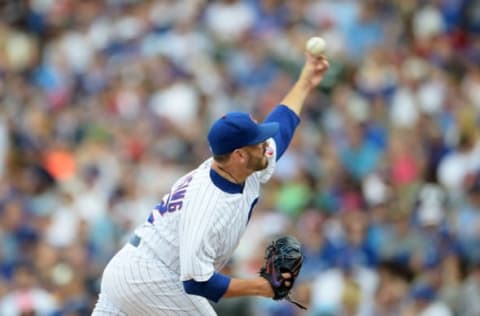Chicago Cubs: Will the real Brian Duensing please stand up?


A few months after the excitement of a World Series championship, the Chicago Cubs brought in relief help in the form of Brian Duensing. Last season, Duensing was superb. This season, however, he has been unable to find his groove.
The offseason of 2016 saw the Chicago Cubs make one of the more under-the-radar moves in bringing in left-handed relief pitcher Brian Duensing. The deal itself was excellent. A one-year deal worth just $2 million, giving the club a low-risk investment with potential upside out of the bullpen.
It manifested into just that, as Duensing finished his 2017 campaign with a very respectable 2.74 ERA in 62 1/3 innings. Duensing rode the success of the regular season into the postseason as well, allowing just one earned run in 5 1/3 innings pitched. Not a significant sample size, but regardless he displayed consistency.
The hope for 2018, then, was for Duensing to once again produce at a consistently high level, or at a consistent level for his age. Unfortunately, this has been far from the case as he has posted a disappointing 7.18 ERA in just 31 1/3 IP along with a horrendous 6.15 FIP. So, the question remains, what has changed between last season and this season?

Chicago Cubs: Pitch-type variance…or lack thereof
Last season, Brian Duensing utilized his variance of pitches at a far higher rate of consistency. This season, he has focused much more heavily on his fastball, seemingly leading to higher contact rates than previous seasons. In 2017, Duensing threw his fastball 28.1 percent of the time. In 2018, that rate has increased to 33.8 percent.
As far as the rest of his pitches are concerned, Duensing’s rate of usage has all seen a decrease, most notably his slider. Last season, Duensing was throwing his slider 24.5 percent of the time. Flipping the script, that has not dropped to just 19.8%. Duensing has notably increased his sinker usage. However, his changeup and cutter usage respectively have both declined.
Decision-making when it comes to pitching in the major leagues is vital. For Duensing, unfortunately, this has led to a myriad of issues plaguing his 2018 season up until this point.

Chicago Cubs: Developing a deeper understanding
Looking further into Brian Duensing’s statistics, measuring last season in comparison to this season, there is a noticeable difference in underlying areas which could more also exacerbate the problem.
One difference, in particular, is the decrease in first pitch strikes. Last season, Duensing posted a 57.6 percent first-pitch strike rate. This season, that rate is down nearly five percent, to 52.7 percent. When Duensing begins a hitters count 1-0, opposing teams have posted a heinous .443 wOBA against Duensing.
Last season, Duensing still did not post great statistics in the situation, however, opposing hitters wOBA was nearly one-hundred points less in comparison. Teams slugged .434 last season in this situational hitting, while this year it is almost 100 points higher at .533. The number of strikeouts for Duensing has also decreased significantly when he does not throw a first-pitch strike.
When Duensing starts a batter with a first-pitch strike, the opposing wOBA drops all the way to a paltry .216 with a .237 slugging percentage. Situational pitching is critical for Duensing and his success moving forward.

Chicago Cubs: Measuring the rest
Getting a little less technical, we can look at the rest of Duensing’s statistics this season relative to last season, and see quite a change. Most importantly there are three stats which have taken a turn for the worst: strikeout percentage, walk percentage, and HR/9.
First, the strikeout percentage for Brian Duensing has seen a significant decrease from last season to this season. Last season, for instance, Duensing was striking batters out at a respectable 23.7 percent. Disappointingly, that has gone way down to a woeful 14.2 percent. The rate of batters per nine innings in 2017 was up to 8.81 while now it is down to just 6.03.
Concerning his walk rate, this is the statistic which has seen the most extreme change. Last season, Duensing lent batters a free pass a lowly 7.0 percent of the time. It has become something out of a horror movie this season. His walk rate is now at an out of control 16.9 percent, and he is posting a -2.7 percent strikeout to walk ratio.
The spike in home runs does no favors. This rate has nearly doubled from his 0.87 HR/9 last year to a whopping 1.44 HR/9 this year.

Chicago Cubs: From beginning until the end
If you look at Duensing’s start to the regular season, he pitched exceptionally well in his appearances. Through March and April, Duensing tossed 8 1/3 innings without allowing a single run and allowing just five total hits.
The month of May saw a minor setback Duensing’s production. However, his 3.86 ERA still rang fair to Midland. Unfortunately, this is where the walks started to become problematic, as he walked seven of the forty batters faced while striking out just five.
June and July have flat out been horrendous for Duensing. He posted a 17.28 ERA in just 8 1/3 innings in June while allowing opponents a .480 wOBA and a .400 batting average. July saw no reprieve as Duensing pitched only 5 1/3 innings, allowing five earned runs and a .353 wOBA. The strange thing for this span is that Duensing permitted hitters just a .158 batting average.
Somehow, it has gotten worse for Duensing. Thus far in the second half, he has pitched just four innings to the tune of an 11.25 ERA. During this time he has given up two home runs and allowed a .390 wOBA. Hitters are slugging .600 against Duensing as well. Nothing more to say than stinky.

Chicago Cubs: Hoping for a bounceback
In reality, it may be the end of the line for Brian Duensing in a Chicago Cubs uniform. The trade deadline is he, and the Cubs are said to still be on the hunt for additional relief help. The club recently traded for Jesse Chavez, who has been phenomenal. It could be a telltale sign as the end.
Still, Duensing provides left-handed relief help which, as many teams are understanding, is challenging to acquire. Recently, the Cubs were attached to the former closer of the San Diego Padres and big lefty Brad Hand however that failed to manifest and Hand found himself shipped to Cleveland.
Next. Talking Cubs-Cards, Hamels and Sosa with Ravech. dark
Duensing needs to figure it out and figure it out quick if he wants a spot moving forward. The looming return of Yu Darvish and the recent acquisition of new left-hander Cole Hamels has pushed Tyler Chatwood to the bullpen.
It could be more difficult for Duensing to stick around for the rest of the year. That being said, the benefit for the Cubs and for Duensing to put it back together would be substantial. Let us hope he can figure it out before it is too late.